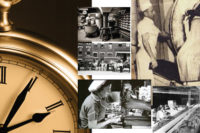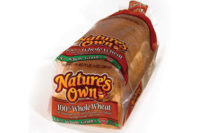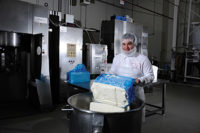Savings-savvy Capistrano’s Bakery combined two small baking operations and renovated a larger, 38,000-sq.-ft. production facility in Phoenix that features a used, multizone, traveling-tray oven it had rebuilt with state-of-the-art features. The oven saved Capistrano’s more than half of the cost of a new model. This, its dedication to customers and more are why we named it our 2014 Bakery of the Year.
Working to be known for its outstanding breads, rolls, artisan products and specialty products, as well as exceptional customer service, the folks at Capistrano’s Bakery, LLC, Phoenix, admit they have a “new” operation that’s not “your typical bakery facility.” After moving into a larger production facility in Phoenix that it renovated two-and-a-half years ago, the group now seems ready for anything.
Primarily serving foodservice customers, Capistrano’s also copacks various products for other bakeries, offering a wealth of carefully crafted breads, rolls, buns, pizza dough, pretzels, natural sourdough loaves and artisan and specialty products that total more than 200 stock-keeping units (SKUs).
The busy, revamped operation has four makeup lines, one of which is dedicated to bread, another for rolls, a less automated version for artisan products and one for specialty products. “The bread and roll lines are our main ‘engines,’ so-to-speak,” notes Allen Herman, operations team leader. The lines feature both new automatic and updated equipment, including a rebuilt, 65-ft.-long, 38-tray traveling-tray oven that was overhauled and redesigned with new technology, at less than half the cost of a new oven, thanks to assistance from Banner-Day, Saginaw, MI.
Hugh Coker, the bakery’s operations consultant and owner of Innovative Bakery Concepts in Phoenix, also worked on the massive project. “Hugh was a vital part of every step in this relocation project, which included the buildout,” Herman points out. “He helped us with the building design, equipment acquisition and layout, production software acquisition and implementation, formulation and in the selection of most of our management associates.”
Rebuilding the oven significantly boosted throughput and efficiencies, observes Jason Link, the bakery’s chief engineer, who designed the line layouts to conveniently fit the new space and coordinated all of the renovation groups and design engineers. “It allowed us to become more sophisticated and more automated,” he says. “We now have more advanced systems to make us faster, more consistent and more productive. When we got onstream, were able to triple our line speeds almost right away.”
Also expediting throughput are a complex network of “racetrack” cooling conveyors, a large walk-in proof box that holds 60 racks of bread, eight rack ovens, one deck oven, two metal detectors, three bread baggers (one of which is new), three fully automatic mixers, a standalone artisan mixer, an intermediate proofer and assorted downstream cooling and packaging equipment.
Quick startup
Capistrano’s transferred equipment from its two smaller, previous facilities and installed them, added new machinery and implemented some new programs. “We installed more high-speed production equipment to meet customer demand as well as our expanding food-safety and sanitation requirements. Now, it’s modern and up-to-date, and we have some room to grow,” Herman says.
Despite all of the dismantling, reassembly, new assembly and troubleshooting, it took only a year to revamp the 38,000-sq.-ft. facility in Phoenix.
As far as the traveling 38-tray oven was concerned, Banner-Day’s CEO Joseph Day says it was old (dating back to the 1960s), but its basic structural “bones” were sound. Still, the five-zone oven required extensive work to meet Capistrano’s current and future needs. Banner-Day installed its Direct Spark Ignition (DSI) system and Power Interruption Protection (PIP) features, which allow direct-fired oven burners to automatically re-light without the need to re-purge the oven in the event of a brief electrical power interruption, as well as several other new components.
First, the oven specialist removed the 65-ft.-long oven from its California location and brought it to Phoenix, Link says. Once the unit arrived at Capistrano’s new plant, components were repaired or replaced, rewired and re-leveled. The oven’s drive system was realigned, and repairs were made to the loader, unloader, internal baffles, trays, combustion air system and burners, and various other elements. Necessary procedures were taken to bring the equipment up to current occupational and fire safety standards, and rectification ignition and flame-sensing components now enhance its reliability.
The oven’s safety performance, productivity, reliability and throughput were notched up by cutting product changeover time via a minimum of one zone space between products, increasing oven heating capacity with the installation of a new, larger combustion air blower and new high-capacity air/gas mixers at each of the 65 direct-fired gas ribbon burners.
The need for steam
Banner-Day also designed and supervised the installation of the steam system.
“The steam zone was also redesigned and upgraded (an essential factor for many artisan products), and a steam-conditioning system now controls the steam temperature and ‘wet steam’ conditions,” Day reports. “Capistrano’s has a special need for steam to properly bake its artisan breads and rolls. We equipped the oven with a steam section and properly conditioned steam, commonly referred to as ‘baker’s steam,’ or ‘wet steam,’ was required.”
Next, with the use of a steam-conditioning tank, Banner-Day designed suitable steam piping and a steam system for the oven, working with the Capistrano’s team, so everyone understood how to properly use the system to achieve their goals.
“We also enhanced the quality and efficiency of the oven through the DSI and our SmartBake precise zone burner management and temperature control,” Day points out. The modular SmartBake controls a given oven zone to within +/- 2 deg F. This allows Capistrano’s to more efficiently manage temperature and lateral heat conditions in the oven.
A new electrical system and programmable logic controls (PLC) were also added, as was a large touchscreen control panel box, built as a separate unit, adjacent to the oven. Installed behind the proof box, the controls incorporate a panel-mounted HMI, (human-machine interface) for full recipe control and were rebuilt from top to bottom, according to Link. “It helps identify which station the bread is in, inside the oven, at a given time, and has five zones that control everything, for an even bake,” he explains.
Day says with the exception of one or two current components and modular enclosure, the entire electrical system was revamped. It took about four and a half months for installation. Building it took another four to five months.
Auto adjustment
“When we change over from one product to the next, the oven automatically adjusts its average bake time to bake the next product as thoroughly and properly as the first,” Link says. Banner-Day linked the oven to an associated infeed/outfeed conveyor and provided multilevel training, especially during the early stages of production. Ongoing support continues to be available.
All of this was happening with Link coordinating this and the rest of the production-floor equipment installation, with Coker’s help. Needless to say, Capistrano’s had its collective hands full.
But press on it did, and the results were more than worth it. “The revamped oven allows us to adjust for bread size, density and other characteristics and bakes beautifully,” Link affirms.
Bread production
Capistrano’s produces as much as 150,000 lb. of product a week, depending on the season and orders. The four production lines run two shifts that range from seven to 12 hours each, depending on the season, five and a half days a week. There are three different time starts for the staff; the packaging crew on these shifts arrives later than the production team.
Bread production begins as bread flour is pumped into the plant’s sifting room from a new, 88,000-lb.-capacity flour silo just outside of the building. “We have room for two of these silos, if we need another,” Herman points out. “We’re optimistic that we might get another one soon. We could also expand the building. There’s great potential here.”
On the day of Snack Food & Wholesale Bakery’s visit, the lines were running assorted items, including Italian white bread, cinnamon raisin and Jewish marble rye. All of the dry ingredients are inspected and scaled as wet ingredients are metered through. Large tanks store the natural sours and poolish. “We also installed an automatic ingredient dispenser when we came here,” Herman says. The sifter outputs enough flour for batches as large as 600-lb.
A mixing we will go
In the mixing area, bread and roll ingredients are dispensed automatically into the large mixing bowls of three fully automatic mixers (there are four mixers total, as an older, standalone spiral mixer is used for the less automated artisan products) on the main plant floor level. Water is also pumped to the mixers.
Other ingredients such as starters, rye seeds, spices, sugar, raisins, malt, poolish and ferments, depending on the bread recipe, are added to the mixers by operators who first scale everything either semi-automatically or by hand. The dough is mixed, inclines into the chunker and then goes into the divider hopper. It’s divided and formed into individual balls of dough. Next, the dough drops into the dough trough and then to the chunker of the bread or roll line. “We’re kosher, so no butter is used,” Herman notes.
Next, the dough pieces enter a rounder that creates large dough balls. “Our artisan and variety-roll lines don’t process things this way—it’s a bit more manual on those lines,” Herman mentions.
Proofing’s important
Next, the dough balls convey on to an intermediate proofer via a cross conveyor and proof at ambient temperatures (around 85 deg. F and ambient relative humidity).
The cross conveyor works with both bread and roll lines, and in this case, drops dough balls into the proofer’s small elevating buckets. “The cross conveyor shifts from one line to the other, depending on what we tell it to do,” Herman explains. “The dough rests in the intermediate proofing system for about 7.5 minutes, though the timespan varies, depending on the product we’re making.”
When ready, the dough exits the intermediate proofer, drops into a moulder, is sheeted automatically, reducing the dough thickness, and gently smoothed into a desired shape. The dough is then dropped into pans that line operators remove and place onto racks. The racks are consequently moved into the 60-rack walk-in proofer and remain there for 45-90 minutes, again, depending on the product being made.
“Artisan breads cannot be rushed,” Herman notes. “Even though this line doesn’t make artisan items, bread needs time to rest and proof by its design.”
Once proofed, the racks of bread pans are removed and moved to the infeed of the new tray oven. “We use a set of eight rack ovens in another area to bake rolls, burger and hot dog buns, sub rolls and special things,” Link points out. “But the bread oven is much larger and high output.”
Baking’s next
A stop gate activates and another group gathers and so on, until the oven is fully loaded with pans.
“The bread bakes exactly how we want it to bake,” Link says. The bread can bake for anywhere from 30-48 minutes, depending on the product, at 375-420 deg. F, again depending on the product. “The oven actually averages the bake time for products to bake thoroughly,” he adds.
After baking, the bread pans exit the oven and head to a refurbished depanner, which quickly releases the golden brown loaves using vacuum-cup grippers. The baked loaves next begin their 3,280-ft.-long trek on the overhead racetrack cooling conveyor, a spiral cooling conveyor and then back on the racetrack, for approximately 60 minutes.
Retail breads and larger foodservice items are sliced and bagged in printed film bags automatically; the bags are clipped closed before heading through a metal detector and being loaded by operators into bakery trays for shipment. “The metal detectors are our main HACCP (Hazard Analysis Critical Control Point),” Link states. “But we also have various internal inspection processes and measure the dough weights at the divider, core temperatures at the proof boxes and the ovens and at packaging. The main bread line does experience frequent changeovers. “There are as many as eight to 10 changes a day for bread varieties and sizes, not to mention packaging line changeovers,” Herman says.
Looking to the future
The bakery property has room for another flour silo, and if demand dictates, Capistrano’s will likely acquire another one. “If we need to expand in terms of equipment, we’ll probably start with mixing and proofing, which are what would start to hold us back if demands really increase,” Link adds.
For now, however, Capistrano’s is glad to be fully functioning in its new space, with its new systems. “Taking on a used oven is always a bit of a risk, but Banner-Day designed all of the internal systems, so that it basically operates like new, and helped with its setup and programming,” Link recalls. “There’s always a more efficient way of doing things, and we’re always driving to become better, so we knew we could take this on. Right now, we’re more focused on process improvements and dialing in on our products to improve even further.” Like the company’s motto states, he says, “‘It Can be Done,’ and we’re getting it done.”











